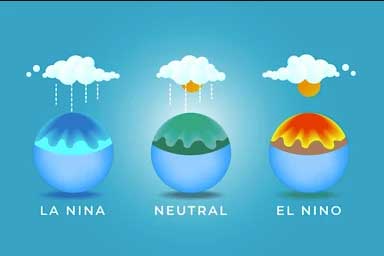Can El Niño, La Niña be predicted—let’s know the latest Technology
Hyderabad based Indian national Centre for ocean information services (INCOIS) has developed a new product to predict the emergence of El Nino and La Nino conditions- their product is known as the Bayesian Convolutional Neural Network (BCNN)
El Nino La Nina
El Niño refers to the above-average sea-surface temperatures that periodically develop across the east-central equatorial Pacific. It represents the warm phase of the ENSO cycle. La Niña refers to the periodic cooling of sea-surface temperatures across the east-central equatorial Pacific.
What is ENSO?
The link to join the course : Online Courses

ENSO is a climate phenomenon characterized by changes in the temperature of waters in the central and eastern tropical Pacific Ocean, accompanied by fluctuations in the overlying atmosphere. It is divided into three phases:
• El Niño: This is the warm phase where the temperature of the eastern Pacific Ocean becomes higher than usual. During this phase, wind patterns weaken, leading to less displacement of warm water and causing the eastern Pacific to warm up.
• La Niña: This is the cool phase where the temperature of the eastern Pacific Ocean becomes lower than usual. In this phase, wind patterns strengthen, leading to more displacement of warm water and causing the eastern Pacific to cool down.
• Neutral: This is the normal phase where the temperature of the eastern Pacific Ocean is cooler compared to the western side (near the Philippines and Indonesia). This condition is due to prevailing wind patterns that move from east to west, pushing warm surface water towards the Indonesian coast, while cooler water rises from below to replace it.
ENSO significantly affects global atmospheric circulation, influencing weather patterns worldwide. Its cycles are irregular and last between 2 to 7 years.

El Nino La Nina
What is BCNN?
• Bayesian Convolutional Neural Network is a type of deep learning model specifically suitable for data analysis and advanced forecasting.
• The model’s predictions are based on the interaction of gradual oceanic changes with atmospheric conditions, providing ample lead time for early forecast issuance. It computes the Nino 3.4 index value to identify various Enso phases and generate forecasts accordingly.
• Weather forecasting models fall into two primary categories:
• Statistical models, which rely on data from diverse countries and regions to predict outcomes, and
• Second dynamic models, which employ High Performance Computers (HPC) to simulate the atmosphere in 3D and are generally more precise than statistical models.
• The BCNN combines the accuracy of dynamic model with AI capabilities to forecast El Niño and La Niña conditions up to 15 months in advance, surpassing other models that typically forecast six to nine months ahead.
What is the prediction at present?
According to the June 5 bulletin, La Niña conditions would emerge during July-September (probability 70-90%) and continue till February 2025.
Best Online Coaching for Civil Service_IAS_ UPSC_IFS_IPS
Free Study Material ENSEMBLE IAS ACADEMY | Call +91 98115 06926
Visit us:- https://ensembleias.com/ | Online Store: https://online.ensemble.net.in/
#ENSOPrediction, #ClimateForecasting, #ElNino #LaNina, #BCNN, #INCOIS, #OceanScience, #WeatherForecasting, #DeepLearning, #ClimateChange, #HyderabadResearch, #BayesianCNN, #GlobalWeatherPatterns, #OceanAtmosphereInteraction, #ClimateTechnology, #AdvancedForecasting, #IndianOceanResearch, #ENSOPhases, #ClimatePhenomena, #EarlyWarningSystems, #PredictiveModeling, #ScientificInnovation, #EnvironmentalScience, #LongTermForecasting, #ClimatePredictability, #HPCInWeather,



